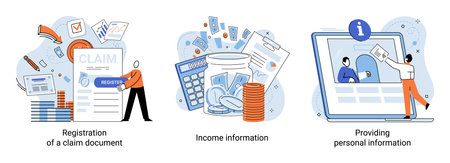Understanding Estimated Taxes in the U.S.
Estimated taxes are periodic payments made to the Internal Revenue Service (IRS) on income that isn’t subject to withholding, such as earnings from self-employment, side gigs, small businesses, or freelance work. In the United States, if you expect to owe at least $1,000 in federal tax for the year after subtracting your withholding and refundable credits, you’re generally required to make these quarterly estimated payments. This obligation is especially relevant for freelancers, independent contractors, and small business owners who do not have an employer automatically withholding taxes from their paychecks.
The IRS expects taxpayers in these categories to pay taxes as income is earned throughout the year. Failure to accurately estimate and pay enough tax each quarter can result in penalties and interest charges. The most common requirements faced by individuals working outside of traditional employment include tracking all sources of income, maintaining detailed records of deductible expenses, and calculating estimated payments using IRS Form 1040-ES. Understanding how estimated taxes work—and staying compliant—starts with organizing your finances so you can confidently track your income and expenses all year long.
2. Setting Up a Reliable Income and Expense Tracking System
To ensure your estimated tax payments are as accurate as possible, it’s essential to have a reliable system for tracking both income and deductible expenses throughout the year. Consistency is key—missing entries or forgetting deductions can result in underpayment penalties or missed savings. Here’s how to choose effective tools and methods tailored to your needs:
Choosing the Right Tracking Method
The best system for you depends on your comfort with technology, the complexity of your finances, and whether you prefer manual or automated solutions. Below is a comparison of popular options used by individuals and small business owners across the U.S.:
| Method | Pros | Cons | Best For |
|---|---|---|---|
| Spreadsheets (Excel, Google Sheets) | – Free or low cost – Customizable – Good for basic tracking |
– Manual data entry – Risk of errors – No automation |
Freelancers, gig workers, simple finances |
| Accounting Software (QuickBooks, FreshBooks) | – Automated transaction import – Built-in tax features – Generates reports |
– Monthly fees – Learning curve – May be more than needed for simple cases |
Small business owners, self-employed professionals |
| Financial Apps (Mint, YNAB) | – Syncs with bank accounts – User-friendly interface – Mobile access |
– Limited customization for business deductions – Security concerns for some users |
Side hustlers, individuals who want automation |
Setting Up Your Tracking Process
1. Categorize All Sources of Income and Expenses
Create separate categories for different income streams (wages, freelance gigs, investments) and deductible expenses (home office, supplies, mileage). This organization makes it easier to identify patterns and calculate estimated taxes.
2. Record Transactions Regularly
Set aside time weekly or bi-weekly to enter transactions. Automated tools can help pull data from your bank, but always review for accuracy.
3. Reconcile with Bank Statements Monthly
This step ensures nothing is missed or duplicated and helps catch any potential errors early.
Pro Tip: Backup Your Data Securely
No matter which method you use, regularly back up your financial records—use cloud storage or an external hard drive to safeguard against data loss.

3. Categorizing Income and Expenses for Tax Purposes
Properly categorizing your income and expenses is essential for accurate estimated tax payments and for maximizing your allowable deductions under U.S. tax law. By organizing your financial data into the correct categories, you’ll simplify reporting on IRS forms like Schedule C or Schedule E, minimize audit risk, and ensure you capture every eligible deduction.
Tips for Organizing Revenue Streams
Separate Business from Personal Finances: Open a dedicated business bank account to keep personal and business transactions apart. This makes it easier to identify taxable income and deductible expenses.
Identify All Sources of Income: Record every revenue stream, including product sales, service fees, freelance payments, commissions, and even interest earned on business accounts. Use clear labels such as “Consulting Income” or “Online Sales” to avoid confusion later.
Track Gross vs. Net Receipts: Log gross receipts (total income before expenses) separately from net income (income after direct costs). This distinction is crucial for correct reporting and compliance with IRS requirements.
Categorizing Deductible Business Expenses
Use Standard IRS Categories: Familiarize yourself with common deductible expense categories such as advertising, office supplies, travel, meals, utilities, insurance, professional fees, and depreciation. Matching your records to these categories will streamline tax prep.
Document Each Expense: Keep receipts and note the business purpose for every transaction. Digital bookkeeping tools often let you attach scanned receipts and add memos for context.
Avoid “Miscellaneous” Overuse: Limit the use of generic categories like “miscellaneous.” The IRS may scrutinize vague entries more closely during an audit.
Practical Organization Strategies
- Set up expense folders (digital or physical) labeled by category and year.
- Regularly update your books—monthly or weekly reviews prevent backlog.
- Leverage accounting software that auto-categorizes based on merchant codes or transaction history.
Maximizing Deductions While Staying Compliant
Accurate categorization doesn’t just make life easier at tax time—it can also uncover deductions you might otherwise miss. Always check IRS guidelines (Publication 535 is a good reference) for any updates on what’s deductible in your industry. If in doubt about how to classify an item, consult a qualified tax professional to ensure compliance while optimizing your tax benefits.
4. Reconciling Accounts and Keeping Records
Accurate estimated tax payments hinge on meticulous record-keeping and account reconciliation. To avoid costly errors or surprises during tax season, it’s essential to implement best practices for reconciling bank statements, preserving receipts, and maintaining organized logs. These habits not only streamline your quarterly tax calculations but also prepare you for potential IRS audits.
Best Practices for Reconciling Bank Statements
Each month, compare your bank statements against your income and expense records to catch discrepancies early. Use the following table to guide your reconciliation process:
| Step | Description |
|---|---|
| Match Transactions | Verify each deposit and withdrawal in your records matches your bank statement. |
| Identify Discrepancies | Highlight any unrecognized charges or missing deposits for investigation. |
| Adjust Records | Update your logs to reflect accurate amounts after resolving discrepancies. |
| Finalize Reconciliation | Confirm all balances match before proceeding with financial analysis or tax preparation. |
Saving Digital or Paper Receipts
The IRS recommends keeping all receipts that support income, deductions, or credits claimed on your return. Consider these strategies:
- Digital Storage: Scan or photograph receipts and store them in cloud-based folders labeled by month or category (e.g., meals, travel, office supplies).
- Paper Filing System: Use accordion files or folders with clear labels for each quarter and expense type.
- Retention Period: Retain receipts for at least three years from the date you file your return, or longer if you claim certain credits or have complex transactions.
Maintaining Organized Logs
An up-to-date log is crucial for tracking both income and deductible expenses. Choose a method that suits your workflow:
- Spreadsheet Templates: Use Excel or Google Sheets to list date, amount, client/vendor, category, and notes for each transaction.
- Accounting Software: Platforms like QuickBooks or FreshBooks can automate much of this process, making quarterly reviews easier.
- Manual Ledger: For those who prefer paper, maintain a detailed notebook with columns mirroring digital templates.
Sample Income & Expense Log Format
| Date | Description | Category | Amount ($) | Notes |
|---|---|---|---|---|
| 01/15/2024 | Consulting Invoice #1023 | Income – Services | $1,500.00 | |
| 01/20/2024 | Coffee Shop Meeting w/Client A | Expense – Meals & Entertainment | $23.50 | Lunch meeting with Client A regarding project scope. |
| 01/28/2024 | Laptop Purchase – Office Depot | Expense – Equipment | $899.99 | Dell XPS 13 for business use. |
The Importance of Consistency and Backups
No matter which tools you use, update your records weekly and back up digital files regularly. This discipline ensures you always have current data for quarterly estimated tax payments and are audit-ready if the IRS requests documentation.
5. Estimating Quarterly Tax Payments
A Step-by-Step Approach to Calculating Your Estimated Taxes
Paying the right amount in estimated taxes each quarter is crucial for avoiding IRS penalties and maintaining healthy cash flow. Heres a step-by-step approach tailored for U.S.-based freelancers, small business owners, and independent contractors:
Step 1: Project Your Annual Income
Begin by estimating your total income for the year. Review your historical earnings, upcoming contracts, and any seasonal fluctuations typical in your industry. Adjust your projections as you go—many businesses experience slow periods or busy seasons that can dramatically affect quarterly income.
Step 2: Subtract Allowable Deductions
Identify all eligible deductions, such as business expenses, home office costs, retirement plan contributions, and health insurance premiums. Accurate recordkeeping throughout the year makes this process easier and ensures you’re not overpaying taxes.
Step 3: Calculate Your Taxable Income
Subtract your total allowable deductions from your projected annual income. The result is your estimated taxable income. This figure forms the basis for determining how much tax you owe.
Step 4: Apply Current IRS Tax Rates and Guidelines
Consult the latest IRS tax tables and self-employment tax rates. The IRS updates these figures annually, so it’s important to verify current information at irs.gov. Calculate both federal income tax and self-employment tax, if applicable.
Step 5: Divide by Four (or Adjust for Seasonal Fluctuations)
Divide your total estimated annual tax liability by four to determine your quarterly payment. If your income isn’t consistent throughout the year, consider using the annualized installment method (IRS Form 2210) to adjust payments based on actual earnings each quarter. This helps avoid overpayment during lean months and underpayment when business picks up.
Step 6: Make Timely Payments
The IRS typically requires estimated tax payments in April, June, September, and January. Mark these dates on your calendar and set reminders to stay compliant. Paying late can trigger penalties—even if you ultimately pay enough by year-end.
Pro Tip: Reassess Quarterly
Your financial situation can change quickly. Review your income and expenses at the end of each quarter and recalculate as needed to ensure your estimated payments remain accurate throughout the year.
6. Using IRS Forms and Online Tools
Leveraging official IRS resources and digital tools can significantly simplify the process of tracking your income and expenses, as well as calculating estimated tax payments. The IRS provides a variety of worksheets and forms, such as Form 1040-ES, which is specifically designed to help you estimate your quarterly tax obligations accurately. By carefully completing these worksheets using up-to-date financial data, you’ll gain clarity on how much to pay each quarter, helping you avoid underpayment penalties.
Additionally, online calculators—available both on the IRS website and through reputable third-party providers—can automate much of the math involved in estimating your taxes. These calculators typically ask for basic information about your income sources, deductions, and credits, then provide quick estimates based on current tax laws. This reduces manual errors and ensures your calculations reflect the latest tax brackets and rules.
E-filing platforms, like IRS Direct Pay or authorized e-file providers, offer convenient ways to submit payments securely and keep digital records for future reference. Many platforms also provide dashboards where you can track payment history and upcoming deadlines, making it easier to stay organized throughout the year. By integrating these IRS forms and online tools into your routine, you streamline compliance with estimated tax requirements while minimizing administrative hassles.
7. Reviewing and Adjusting Your System
Regularly reviewing your income and expense tracking system is essential to ensure its effectiveness for accurate estimated tax payments. Performing periodic self-audits can help you catch errors early, stay organized, and reduce stress when tax season arrives.
Conducting Self-Audits
Set aside time monthly or at least quarterly to review your financial records. Compare your recorded transactions against bank statements, receipts, and digital payment records. Look for missing entries, duplicates, or misclassified expenses. This proactive approach helps you maintain complete and accurate data throughout the year.
Evaluating Your Tracking Methods
Assess whether your current method—be it spreadsheets, accounting software, or mobile apps—still meets your needs as your business grows or changes. If you find recurring issues such as missed deductions or confusing categories, it may be time to upgrade your tools or seek professional advice.
Making Improvements for Next Tax Season
After each self-audit, note any challenges you faced and consider solutions. For example, if manual entry leads to mistakes, explore automation features in software like QuickBooks or FreshBooks. If organizing receipts is a struggle, use apps that let you snap photos and digitally store them. Continuously improving your system not only boosts accuracy but also makes estimated tax payments less daunting.
By routinely reviewing and adjusting your tracking process, you create a reliable financial foundation that simplifies tax compliance and gives you peace of mind all year long.


